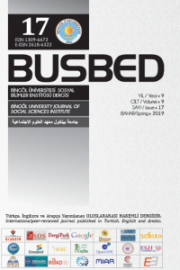OSMANLI DEVLETİ’NDE UYGULANAN ADEM-İ MERKEZİYETÇİ BİR YÖNETİM MODELİ: MİLLET SİSTEMİ
DECENTRALIZATION ADMINISTRATION MODEL APPLIED IN THE OTTOMAN STATE: MILLET SYSTEM
Author(s): Konur Alp DemirSubject(s): Political history, Government/Political systems, The Ottoman Empire, Inter-Ethnic Relations
Published by: Bingöl Üniversitesi Sosyal Bilimler Enstitüsü
Keywords: Ottoman Empire; Millet System; Decentralization; Tanzimat Period; Community Management;
Summary/Abstract: The Ottoman Empire was a state which had dominated different continents where different languages were spoken and people of different ethnic backgrounds lived within their borders. Special administration models are needed to administrate such a state. Because it is not an easy task to orient different elements to a single target without allowing them to cause problems and to adopt new methods to prevent a possible disintegration at a later stage. In order to avoid the drawbacks identified in this direction and to achieve the stated objectives, the administration model adopted by the Ottoman Empire became the millet system. With the millet system, the Ottoman State acted on the community rather than on the nation. Because the nation system, instead of referring to ethnic origin, had the claim of accepting the concept of religion as the unifying element. In this context, in this study, the millet system, which has been successfully applied in the Ottoman Empire for a certain period and which allows the masterful managing diversity, has been examined.
Journal: Bingöl Üniversitesi Sosyal Bilimler Enstitüsü Dergisi (BUSBED)
- Issue Year: 9/2019
- Issue No: 17
- Page Range: 411-426
- Page Count: 16
- Language: Turkish

